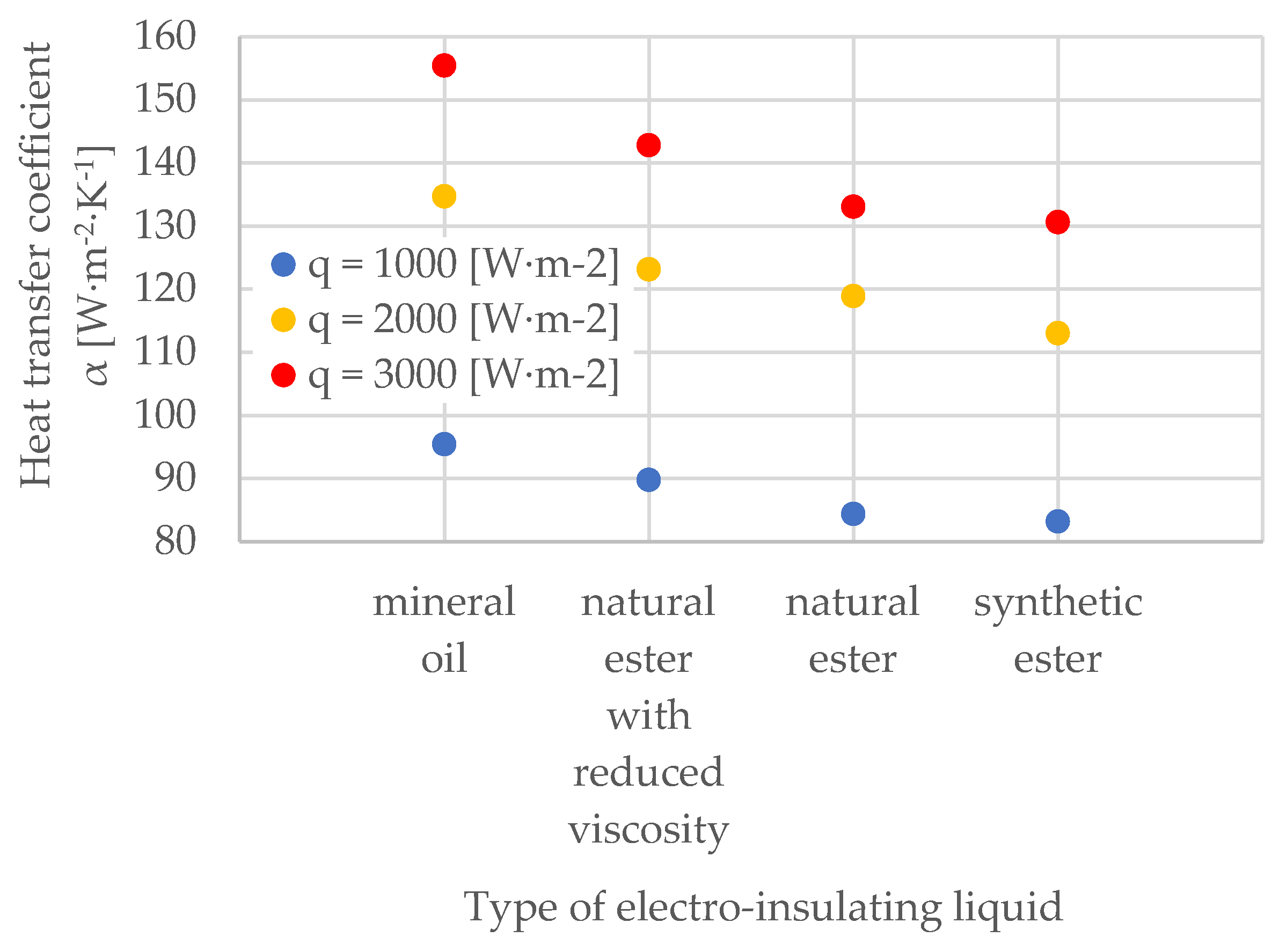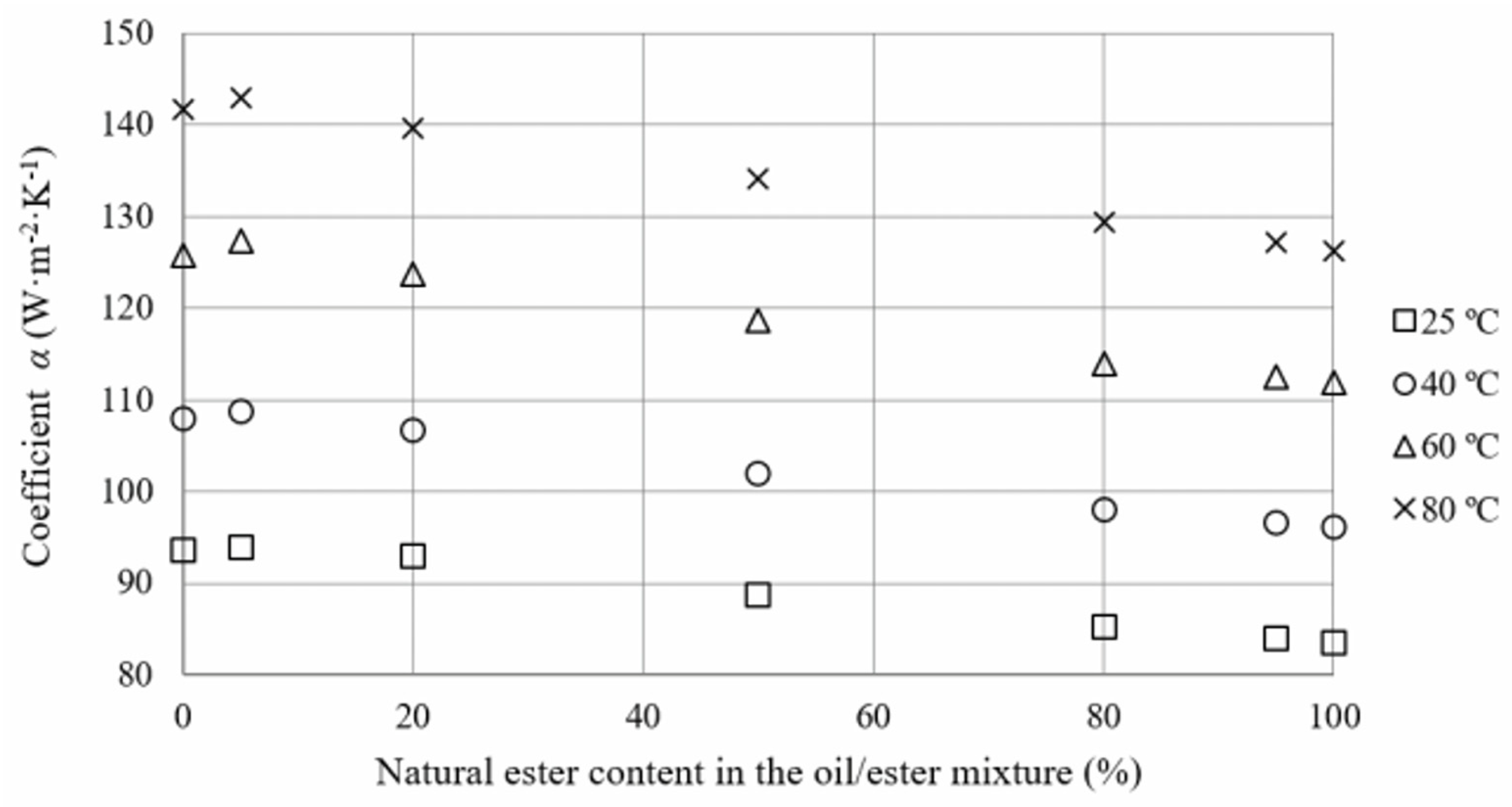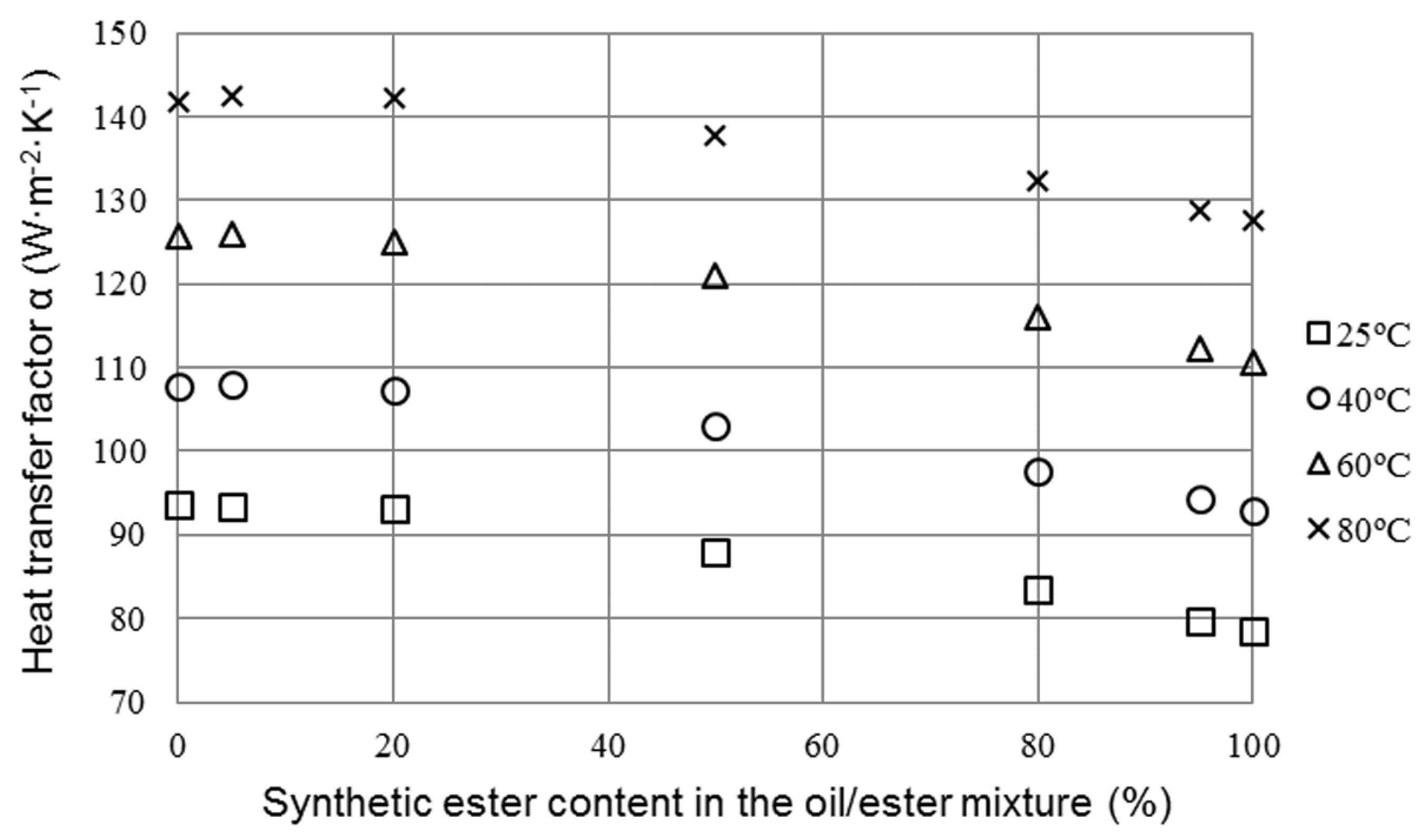Evaluation of Thermal Properties of Various Insulating Liquids Used in Power Transformers
Abstract
:1. Introduction
2. Theoretical Foundation
2.1. Scope of Tests of Thermal Conductivity Coefficient λ and Heat Transfer Coefficient α
2.2. Coefficient of Thermal Conductivity λ of Paper–Oil Insulation
2.3. Heat Transfer Coefficient α of Insulating Liquids
2.4. Summary
3. Introduction to Results and Discussion
- In paper–oil insulation ΔTpaper;
- In an insulating liquid, in the remaining volume of transformer, near paper–oil insulation ΔTpaper-liquid;
- In the insulating liquid, in the remaining volume of transformer, near the transformer tank ΔTliquid-tank.
- The thickness of the paper–oil insulation p is equal to 1.5 mm;
- The moisture content of the paper–oil insulation is equal to about 1%;
- The temperature, on the basis of which the thermal conductivity coefficient λ of the paper–oil insulation in Figure 1 was selected, is equal to 100 °C;
- The surface heat load, which was used to determine the ΔTpaper value, is equal to 3000 W⸱m−2;
- The surface heat load q, on the basis of which the heat transfer coefficient α of the liquid near the paper–oil insulation from Figure 2 was selected, and which was adopted for the determination of the ΔTpaper-liquid value, is equal to 3000 W⸱m−2;
- Surface heat load q, on the basis of which the heat transfer coefficient α of the liquid near the transformer tank from Figure 2 was selected, and which was used to determine the value of ΔTliquid-tank, is equal to 1000 W⸱m−2.
4. Results
5. Discussion
- Thermal conductivity coefficient λ;
- Specific heat cp;
- Kinematic viscosity υ;
- Thermal expansion coefficient β;
- Density ρ.
6. Conclusions
Funding
Data Availability Statement
Conflicts of Interest
References
- Aruna, M.; Vasudev, N.; Ravi, K.N. Novel Insulation System in Power Transformer. In Proceedings of the 10th International Conference on the Properties and Applications of Dielectric Materials, Bangalore, India, 24–28 July 2012. [Google Scholar]
- Shane, C.P. Distribution and power transformers. IEEE Ind. Appl. Mag. 2000. [Google Scholar]
- IEC 60076-7:2018; Power Transformers-Part 7: Loading Guide for Oil—Immersed Power Transformers. IEC: Geneva, Switzerland, 2018; pp. 4–56.
- Ebenezer, M.; Rajkumar, M.R.; Chandramohanan Nair, P.S. Determination of Temperature Distribution and Reduction of Life of a Dry Type Three Phase Transformer. In Proceedings of the 10th International Conference on the Properties and Applications of Dielectric Materials, Bangalore, India, 24–28 July 2012; IEEE: Piscataway, NJ, USA, 2012. [Google Scholar]
- Notingher, P.V.; Tanasescu, G. Determination of Estimated, Consumed and Remaining Lifetimes of Paper—Oil Transformers Insulation Based on Winding Insulation Resistance. In Proceedings of the International Conference on High Voltage Engineering and Application (ICHVE), Athens, Greece, 10–13 September 2018; IEEE: Piscataway, NJ, USA, 2019. [Google Scholar]
- Luo, C.; Li, C.; Wan, X.; Zhao, Z. Convective Heat Transfer Coefficient of Insulation Paper–Oil Contact Surface of Transformer Vertical Oil Channel. Coatings 2023, 13, 81. [Google Scholar] [CrossRef]
- Mansour, D.E.A.; Elsaeed, A.M. Heat Transfer Properties of Transformer Oil-Based Nanofluids Filled with Al2O3 Nanoparticles. In Proceedings of the International Conference of Power and Energy (PECon), Kuching, Malaysia, 1–3 December 2014; IEEE: Piscataway, NJ, USA, 2015. [Google Scholar]
- Bukreev, A.; Vinogradov, A. A Method for Estimating Power Losses in Power Transformers without Disconnecting them from the Mains and with Ranking for Short-Circuit Losses, Load Losses and Idling Losses. In Proceedings of the 4th International Conference on Control Systems, Mathematical Modelling, Automation and Energy Efficiency (SUMMA), Lipetsk, Russia, 9–11 November 2022; IEEE: Piscataway, NJ, USA, 2022. [Google Scholar]
- Steinmetz, T.; Cranganu-Cretu, B.; Smajic, J. Investigations of No-Load and Load Losses in Amorphous Core Dry-Type Transformers. In Proceedings of the XIX International Conference on Electrical Machines (ICEM 2010), Rome, Italy, 6–8 September 2010; IEEE: Piscataway, NJ, USA, 2010. [Google Scholar]
- Suechoey, B.; Tadsuan, S.; Khluabwannarat, P.; Chompoo-Inwai, C. An Analysis of Total Loss and Temperature of Oil-Immersed Transformer with Short Circuit Test Linear Load and Non-Linear Load. In Proceedings of the International Power Engineering Conference, Singapore, 29 November–2 December 2005; IEEE: Piscataway, NJ, USA, 2005. [Google Scholar]
- Sadati, S.B.; Tahani, A.; Darvishi, B.; Dargahi, M.; Yousefi, H. Comparison of Distribution Transformer Losses and Capacity Under Linear and Harmonic Loads. In Proceedings of the 2nd International Power and Energy Conference, Johor Bahru, Malaysia, 1–3 December 2008; IEEE: Piscataway, NJ, USA, 2009. [Google Scholar]
- Martínez, V.L.; López, E.P.; Romeu, J.M.; Monrós, C.A.; Cañamero, L.M. Assessment of Load Losses Caused by Harmonic Currents in Distribution Transformers Using the Transformer Loss Calculator Software. Environments 2023, 10, 177. [Google Scholar] [CrossRef]
- Dua, R.; Bhandari, N.; Kumar, V. Multi-criteria optimization for obtaining efficiently blended transformer oils. IEEE Trans. Dielectr. Electr. Insul. 2008, 15, 879–887. [Google Scholar] [CrossRef]
- Perrier, C.; Beroual, A. Experimental Investigations on Insulating Liquids for Power Transformers: Mineral, Ester, and Silicone Oils. IEEE Electr. Insul. Mag. 2009, 25, 6–13. [Google Scholar] [CrossRef]
- Rozga, P.; Skowron, A. Changing the Dielectric Dissipation Factor of Transformer Fluid based on Synthetic Ester in the Condition of a Concentrated Heat Flux. In Proceedings of the International Conference on High Voltage Engineering and Application ICHVE, Shanghai, China, 17–20 September 2012. [Google Scholar]
- Karaman, H.S.; Mansour, D.E.A.; Lehtonen, M.; Darwish, M.M.F. Condition Assessment of Natural Ester–Mineral Oil Mixture Due to Transformer Retrofilling via Sensing Dielectric Properties. Sensors 2023, 23, 6440. [Google Scholar] [CrossRef] [PubMed]
- Perrier, C.; Beroual, A.; Bessede, J.L. Experimental Investigations on different Insulating Liquids and Mixture for Power Transformers. In Proceedings of the International Symposium on Electrical Insulation, Indianapolis, IN, USA, 19–22 September 2004. [Google Scholar]
- Fofana, I.; Wasserberg, V.; Borsi, H. Challenge of mixed insulating liquids for use in high-voltage transformers, part 2: Investigations of mixed liquid impregnated paper insulation. IEEE Electr. Insul. Mag. 2002, 18, 4. [Google Scholar]
- Li, J.; Liao, R.; Yang, L. Investigation of Natural Ester Based Liquid Dielectrics and Nanofluids. In Proceedings of the International Conference on High Voltage Engineering and Application ICHVE, Shanghai, China, 17–20 September 2012. [Google Scholar]
- Aksamit, P.; Zmarzly, D. Dielectric Properties of Fullerene-Doped Insulation Liquids. In Proceedings of the Conference on Electrical Insulation and Dielectric Phenomena, Kansas City, MO, USA, 15 October 2009. [Google Scholar]
- Li, J.; Zhang, Z.; Zou, P. Preparation of a vegetable oil-based nanofluids and investigation of its breakdown and dielectric properties. IEEE Electr. Insul. Mag. 2012, 28, 43–50. [Google Scholar] [CrossRef]
- Makmud, M.Z.H.; Illias, H.A.; Chee, C.Y.; Dabbak, S.Z.A. Partial discharge in nanofluid insulation material with conductive and semiconductive nanoparticles. Materials 2019, 12, 816. [Google Scholar] [CrossRef] [PubMed]
- Kunakorn, A.; Pramualsingha, S.; Yutthagowith, P.; Nimsanong, P.; Kittiratsatcha, S. Accurate Assessment of Moisture Content and Degree of Polymerization in Power Transformers via Dielectric Response Sensing. Sensors 2023, 23, 8236. [Google Scholar] [CrossRef] [PubMed]
- Dombek, G.; Nadolny, Z.; Przybylek, P.; Lopatkiewicz, R.; Druzynski, L.; Boczar, T.; Tomczewski, A. Effect of Moisture on the Thermal Conductivity of Cellulose and Aramid Paper Impregnated with Various Dielectric Liquids. Energies 2020, 13, 4433. [Google Scholar] [CrossRef]
- Goscinski, P.; Nadolny, Z.; Tomczewski, A.; Nawrowski, R.; Boczar, T. The Influence of Heat Transfer Coefficient α of Insulating Liquids on Power Transformer Cooling Systems. Energies 2023, 16, 2627. [Google Scholar] [CrossRef]
- Nadolny, Z.; Dombek, G. Thermal Properties of Mixtures of Mineral Oil and Natural Ester in Terms of their Application in the Transformer. E3S Web Conf. 2017, 19, 01040. [Google Scholar] [CrossRef]
- Nadolny, Z.; Dombek, G.; Przybylek, P. Thermal Properties of a Mixture of Mineral Oil and Synthetic Ester in Terms of Its Application in the Transformer. In Proceedings of the IEEE Conference on Electrical Insulation and Dielectric Phenomena (CEIDP), Toronto, Canada, 16–19 October 2016. [Google Scholar] [CrossRef]
- Dombek, G.; Nadolny, Z. Thermal Properties of a Mixture of Synthetic and Natural Esters in Terms of their Application in High Voltage Power Transformers. Maint. Reliab. 2017, 19, 62–67. [Google Scholar] [CrossRef]
- Dombek, G.; Nadolny, Z.; Marcinkowska, A. Effects of Nanoparticles Materials on Heat Transfer in Electro-Insulating Liquids. Appl. Sci. 2018, 8, 2538. [Google Scholar] [CrossRef]
- García, B.; Ortiz, A.; Renedo, C.; García, D.F.; Montero, A. Use Performance and Management of Biodegradable Fluids as Transformer Insulation. Energies 2021, 14, 6357. [Google Scholar] [CrossRef]
- Radwan, A.A.; Diab, A.A.Z.; Elsayed, A.-H.M.; Mohamed, Y.S.; Haes Alhelou, H.; Siano, P. Transformers Improvement and Environment Conservation by Using Synthetic Esters in Egypt. Energies 2021, 14, 1992. [Google Scholar] [CrossRef]
- Khan, S.A.; Tariq, M.; Khan, A.A.; Alamri, B.; Mihet-Popa, L. Assessment of Thermophysical Performance of Ester-Based Nanofluids for Enhanced Insulation Cooling in Transformers. Electronics 2022, 11, 376. [Google Scholar] [CrossRef]
- Przybylek, P. Thermal Ageing of Dry Cellulose Paper Impregnated with Different Insulating Liquids—Comparative Studies of Materials Properties. Energies 2024, 17, 784. [Google Scholar] [CrossRef]
- Münster, T.; Werle, P.; Hämel, K.; Preusel, J. Thermally Accelerated Aging of Insulation Paper for Transformers with Different Insulating Liquids. Energies 2021, 14, 3036. [Google Scholar] [CrossRef]
- Hiriyanna, M.N.; Basavaraju, A.; Kumar, M.A.; Gurunathegowda, G.; Shanmugam, G. Performance Enhancement of Aged Mineral Oil by Blending Synthetic Ester for Transformer Insulation Applications. Eng. Proc. 2023, 59, 136. [Google Scholar] [CrossRef]
- Amalanathan, A.J.; Zdanowski, M.; Sarathi, R. Streaming Electrification of Different Insulating Fluids in Power Transformers. Energies 2022, 15, 8121. [Google Scholar] [CrossRef]
- Bilal Riaz, M.; Rehman, A.U.; Awrejcewicz, J.; Akgül, A. Power Law Kernel Analysis of MHD Maxwell Fluid with Ramped Boundary Conditions: Transport Phenomena Solutions Based on Special Functions. Fractal Fract. 2021, 5, 248. [Google Scholar] [CrossRef]






| Temperature | SE | SE + SPAN 20 | SE + SPAN 20 + TiO2 |
|---|---|---|---|
| 25 °C | 83.41 | 83.54 | 85.61 |
| 40 °C | 98.44 | 98.78 | 100.24 |
| 60 °C | 116.84 | 115.98 | 118.33 |
| 80 °C | 134.13 | 134.39 | 135.95 |
| Insulating Liquid | ΔTpaper | ΔTpaper-liquid | ΔTliquid-tank | ΔTliquid = ΔTpaper-liquid + ΔTliquid-tank | ΔTtotal |
|---|---|---|---|---|---|
| Cellulose paper | |||||
| mineral oil | 21.7 | 15.9 | 7.7 | 23.6 | 45.3 |
| synthetic ester | 20.4 | 17.4 | 8.9 | 26.3 | 46.7 |
| natural ester | 18.8 | 16.7 | 7.8 | 24.5 | 43.3 |
| Aramid paper | |||||
| mineral oil | 24.9 | 15.9 | 7.7 | 23.6 | 48.4 |
| synthetic ester | 23.4 | 17.4 | 8.9 | 26.3 | 49.8 |
| natural ester | 22.5 | 16.7 | 7.8 | 24.5 | 47.0 |
| Nature of the Flow | Gr⸱Pr | c | n |
|---|---|---|---|
| no flow | <10−3 | 0.45 | 0 |
| laminar flow | 10−3 ÷ 5 × 102 | 1.18 | 0.125 |
| transitional flow | 5 × 10−3 ÷ 2 × 107 | 0.54 | 0.250 |
| turbulent flow | >2 × 107 | 0.14 | 0.333 |
| 25 °C | 40 °C | 60 °C | 80 °C | |
|---|---|---|---|---|
| Thermal conductivity λ [W⸱m−1⸱K−1] | ||||
| mineral oil | 0.133 | 0.130 | 0.128 | 0.126 |
| synthetic ester | 0.158 | 0.156 | 0.153 | 0.151 |
| natural ester | 0.182 | 0.180 | 0.178 | 0.175 |
| specific heat cp [J⸱kg−1⸱K−1] | ||||
| mineral oil | 1902 | 1974 | 2077 | 2187 |
| synthetic ester | 1905 | 1964 | 2052 | 2149 |
| natural ester | 2028 | 2082 | 2166 | 2259 |
| kinematic viscosity υ [mm2⸱s−1] | ||||
| mineral oil | 17.1 | 9.6 | 5.4 | 3.4 |
| synthetic ester | 55.1 | 28.3 | 14.0 | 8.1 |
| natural ester | 56.3 | 32.7 | 18.3 | 11.5 |
| density ρ [kg⸱m−3] | ||||
| mineral oil | 867 | 857 | 845 | 832 |
| synthetic ester | 964 | 953 | 940 | 926 |
| natural ester | 917 | 908 | 892 | 880 |
| thermal expansion coefficient β [K−1] | ||||
| mineral oil | 0.00075 | 0.00076 | 0.00078 | 0.00080 |
| synthetic ester | 0.00076 | 0.00077 | 0.00078 | 0.00079 |
| natural ester | 0.00074 | 0.00076 | 0.00078 | 0.00080 |
Disclaimer/Publisher’s Note: The statements, opinions and data contained in all publications are solely those of the individual author(s) and contributor(s) and not of MDPI and/or the editor(s). MDPI and/or the editor(s) disclaim responsibility for any injury to people or property resulting from any ideas, methods, instructions or products referred to in the content. |
© 2024 by the author. Licensee MDPI, Basel, Switzerland. This article is an open access article distributed under the terms and conditions of the Creative Commons Attribution (CC BY) license (https://creativecommons.org/licenses/by/4.0/).
Share and Cite
Nadolny, Z. Evaluation of Thermal Properties of Various Insulating Liquids Used in Power Transformers. Energies 2024, 17, 3037. https://doi.org/10.3390/en17123037
Nadolny Z. Evaluation of Thermal Properties of Various Insulating Liquids Used in Power Transformers. Energies. 2024; 17(12):3037. https://doi.org/10.3390/en17123037
Chicago/Turabian StyleNadolny, Zbigniew. 2024. "Evaluation of Thermal Properties of Various Insulating Liquids Used in Power Transformers" Energies 17, no. 12: 3037. https://doi.org/10.3390/en17123037






